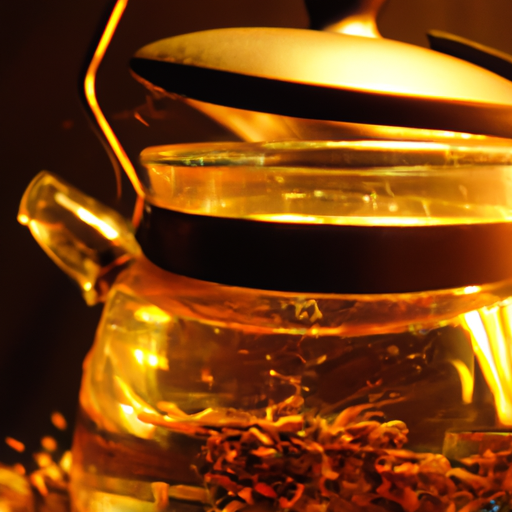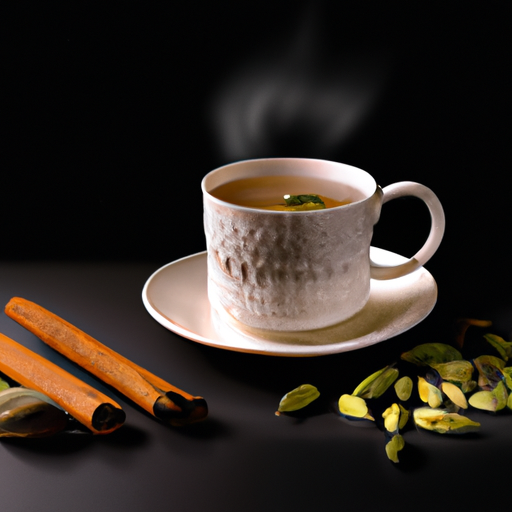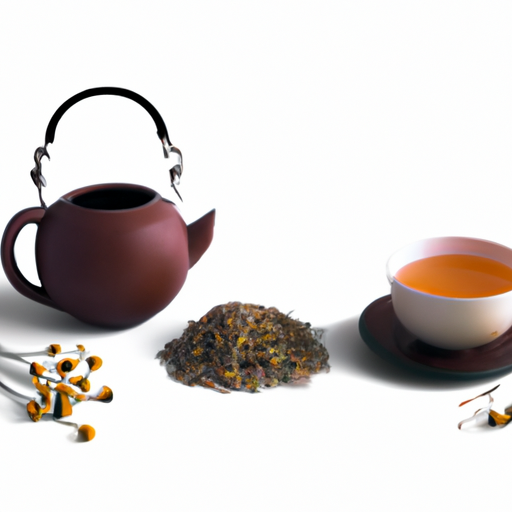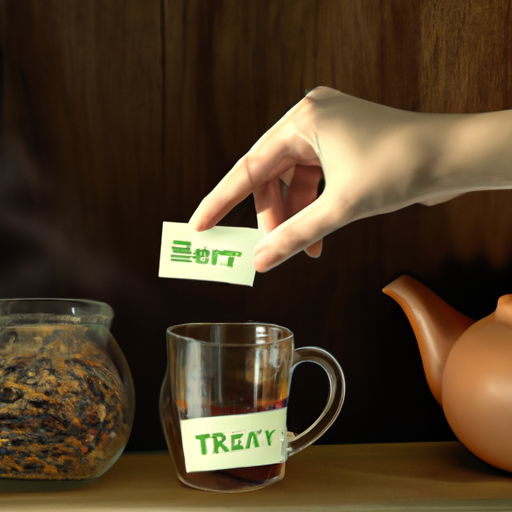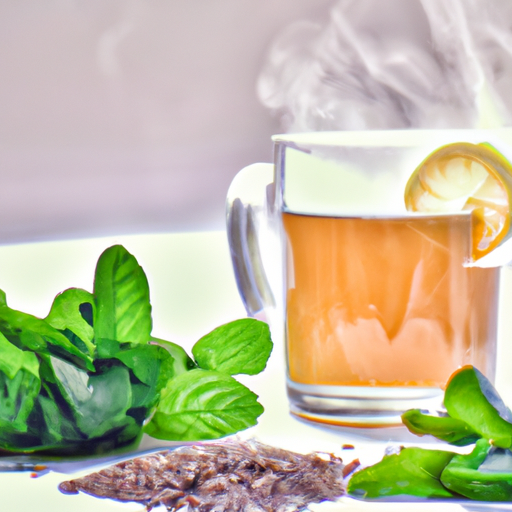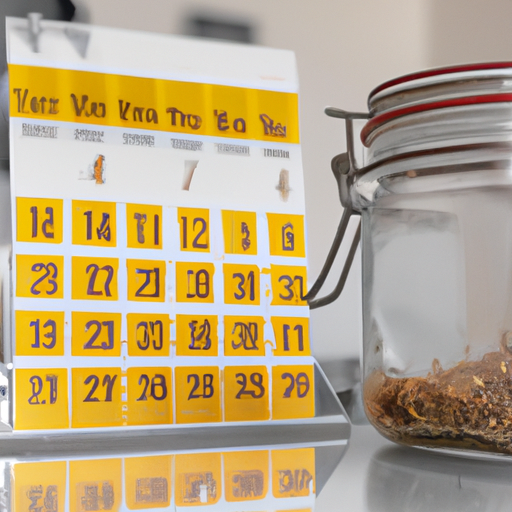I’m totally enamored with Korean barley tea. It’s an invigorating drink suitable for all times of the day, possessing a delightful nutty taste that keeps me coming back for more.
After drinking it for years, I decided that it was time to learn how to brew it myself. And let me tell you, it’s so much easier than I ever thought it would be!
In this article, I’m going to walk you through the process of brewing Korean barley tea step by step. From gathering your ingredients to serving the finished product, I’ll cover everything you need to know to make a perfect pot of tea every time.
So if you’re a fan of this delicious beverage and want to learn how to make it at home, keep reading!
Key Takeaways
- Korean barley tea is a refreshing beverage with a nutty flavor that can be brewed easily at home using pearl or roasted barley and additional ingredients for flavor and health benefits.
- The tea is high in antioxidants and natural diuretics, aids digestion, improves blood circulation, and reduces stress, making it a great alternative to sugary drinks with no caffeine or calories.
- To brew the perfect cup of Korean barley tea, it is important to rinse and toast barley before brewing, boil water at the right temperature, use filtered water, steep for 5-10 minutes, and use a strainer. Honey or lemon can be added for flavor, and the tea can be enjoyed warm or cold, paired with sweet treats, or infused with different flavors.
- Choosing the right strainer is also important, as mesh, cloth, cheesecloth, or coffee filter options all have their pros and cons. Experimenting with different water-to-tea ratios and brewing times can also affect the taste of the tea.
Gather Your Ingredients
Now it’s time to gather all the ingredients you need for your delicious Korean barley tea! The first thing you need is barley. You can use either pearl barley or roasted barley, depending on your preference. Pearl barley has a mild taste, while roasted barley is more robust and nutty. You can also find barley tea bags at Korean grocery stores.
Variations of barley tea are endless! You can add other ingredients to your barley tea, such as corn silk, brown rice, and herbs like mint and chamomile. These ingredients can enhance the flavor of your barley tea and provide additional health benefits. Barley tea is known to help with digestion and detoxification, while corn silk is believed to have diuretic properties.
Not only does barley tea taste great, but it also has many health benefits. Barley tea is high in antioxidants, which can help protect your body from free radicals and reduce the risk of chronic diseases. It is also a natural diuretic, which can help reduce bloating and prevent urinary tract infections.
Now that you know what ingredients you need and the benefits of barley tea, let’s move on to the next step: rinsing and toasting the barley.
Rinse and Toast the Barley
Before we start toasting the barley, it’s important to rinse it thoroughly. This removes any impurities or dirt that may be present.
Toasting the barley also adds an extra layer of flavor to the tea. By doing this step, we can bring out the nutty notes of the barley and enhance the overall taste of the tea.
Importance of Rinsing
To get the best flavor from your barley tea, make sure to give the barley a good rinse under cold water, as the saying goes, ‘cleanliness is next to godliness.’ Rinsing the barley before brewing has many benefits. Firstly, it removes any dirt or debris that may be present on the grains. Secondly, it helps to remove any excess starch or tannins that can make the tea taste bitter. Lastly, rinsing helps to cool down the barley and prevent it from losing any of its natural oils or flavors during the brewing process.
When rinsing the barley, it’s important to use cold water as hot water can cause the grains to cook, which can affect the flavor of the tea. It’s recommended to rinse the barley for a few minutes until the water runs clear. Once the barley is rinsed, it’s ready to be toasted for extra flavor. Incorporating this simple step into your brewing process will greatly enhance the taste of your Korean barley tea.
Toasting for Extra Flavor
Toasting adds a delicious nutty aroma and flavor to your cup of roasted grain infusion. When using the toasting technique, it’s important to pay close attention to the heat level and time to achieve the desired flavor enhancement.
Here are three reasons why toasting is an important step in brewing Korean barley tea:
-
Enhances the Nutty Aroma: By toasting the barley, it releases the nutty aroma that’s unique to roasted grains. The aroma is so inviting that it’ll make you want to take a sip even before the tea is ready.
-
Adds Depth to the Flavor: Toasting the grains adds a depth of flavor that isn’t present in raw grains. This enhanced flavor profile makes the tea more enjoyable to drink, especially on a cold day.
-
Creates a Beautiful Color: Toasting the barley gives it a beautiful golden brown color that adds to the visual appeal of the tea. It’s a feast for both the eyes and the senses.
Now that we’ve toasted the barley, it’s time to move on to the next step: boiling the water.
Boil the Water
Well, if you want your water to be hot enough to brew some delicious Korean barley tea, you’re gonna have to boil it. Boiling the water is a crucial step to ensure that the tea is brewed properly. The water temperature is important for the tea to extract the right amount of flavor and aroma from the barley.
To achieve the perfect water temperature for brewing Korean barley tea, you can use a thermometer to measure the temperature. The ideal temperature for brewing is between 190°F to 200°F (88°C to 93°C). If you don’t have a thermometer, you can boil the water and let it cool for a few minutes before pouring it over the barley.
Another important factor to consider is the quality of the water you use. Using filtered water is highly recommended as it removes any impurities and ensures that the tea tastes clean and pure. Tap water can contain chemicals or minerals that can affect the taste of the tea.
Now that the water is boiled and ready to use, it’s time to add the barley to the pot. The next step is crucial in bringing out the full flavor and aroma of the barley.
Add the Barley to the Pot
Now that the water’s come to a boil, it’s time to add the barley to the pot. I usually measure out about a cup of barley for every 4 cups of water, but you can adjust the amount based on your preference.
As I add the barley to the pot, I like to give it a quick stir to make sure it’s evenly distributed. Mixing techniques are important when brewing tea as they can affect the flavor and aroma of the final product.
Barley tea is a popular beverage in Korea, and for good reason. In addition to its delicious nutty flavor, barley tea has a number of health benefits. It’s rich in antioxidants, which help protect your cells from damage caused by free radicals. It’s also believed to aid in digestion and improve circulation. Plus, with no caffeine or calories, it’s a great alternative to sugary drinks.
Once the barley’s in the pot, it’s time to let it steep. But before we get to that, let’s talk about the next step: covering the pot. This is important because it helps to trap in the flavor and aroma of the tea.
I usually cover the pot with a lid, but if you don’t have one, you can use a piece of aluminum foil or even a plate.
Now, let’s move on to the next step and learn how to steep the tea.
Steep the Tea
Let’s get to the good part and steep this delicious nutty beverage to perfection! The key to brewing Korean barley tea is in the steeping process. Here are some tips to help you brew the perfect cup of barley tea.
First, bring the water to a boil before adding the barley. This will help the barley release its nutty flavor and aroma. Once you’ve added the barley, let it steep for about 5-10 minutes. The longer you steep, the stronger the flavor will be, so adjust the time to your liking.
Second, use a strainer to separate the barley from the tea. This will prevent any leftover barley from floating around in your cup. You can also add honey or lemon to your tea to sweeten or add a tangy twist to the flavor.
By steeping the tea properly, you can unlock the full potential of barley tea’s health benefits. Barley tea is rich in antioxidants and has been known to aid in digestion, improve blood circulation, and even reduce stress.
So sit back, relax, and enjoy the delicious and healthy benefits of Korean barley tea. Next, let’s strain the tea to remove any excess barley.
Strain the Tea
Now that the tea has steeped for the appropriate amount of time, it’s time to strain it.
Choosing the right strainer is important to ensure that the tea is filtered properly. I like to use a fine mesh strainer to catch any loose tea leaves or debris.
It’s also important to avoid bitterness by not squeezing the tea bags or pressing on the leaves too hard.
Choosing the Right Strainer
To ensure a smooth and satisfying cup of Korean barley tea, it’s crucial to pick the right strainer. Here are some things to consider when choosing the right strainer for your Korean barley tea:
-
Mesh vs cloth: Mesh strainers are typically made of metal and have a fine weave that is great for catching small particles. Cloth strainers are made of cotton or gauze and are great for catching larger particles.
-
Metal vs plastic: Metal strainers are durable and long-lasting, but can sometimes affect the flavor of the tea. Plastic strainers are lightweight and easy to clean, but can be less sturdy.
-
Size and shape: The size and shape of the strainer can affect how much tea is strained and how quickly it is strained. A larger strainer may be best for brewing larger batches of tea, while a smaller strainer may be best for individual cups.
-
Cleaning and maintenance: Some strainers are easier to clean than others. Mesh strainers can sometimes be difficult to clean if particles get stuck in the weave, while cloth strainers can be easily washed and reused.
-
Alternatives to strainers: If you don’t have a strainer, you can use a cheesecloth or coffee filter instead.
When choosing the right strainer, make sure to consider your personal preferences and brewing needs. Once you’ve got the right strainer, you can move on to the next step of avoiding bitterness in your Korean barley tea.
Avoiding Bitterness
If you don’t want your cup of Korean barley tea to taste bitter, preventing bitterness is key. One way to do this is by adjusting the brewing time. Steeping the tea for too long can lead to a bitter taste. On the other hand, if you don’t steep it long enough, the tea may be weak and lacking in flavor.
The ideal brewing time for Korean barley tea is around 3-5 minutes. However, this may vary depending on personal preference. Another factor that can affect the taste of your tea is the water-to-tea ratio. A general rule of thumb is to use 1-2 tablespoons of tea per 500ml of water. However, you can adjust this ratio to your liking.
If you prefer a stronger flavor, use more tea. If you prefer a milder taste, use less tea. By experimenting with different ratios and brewing times, you can find the perfect balance for your taste buds. Now that you’ve learned how to prevent bitterness and adjust the brewing time and ratio, it’s time to serve and enjoy your Korean barley tea!
Serve and Enjoy!
When you’re ready to enjoy your freshly brewed Korean barley tea, simply pour a cup, kick back, and savor the rich, nutty flavor.
Here are three ways to take your tea experience to the next level:
-
Tea pairing: Pair your barley tea with a sweet treat like Korean rice cakes or mochi. The contrast of the nutty flavor with the sweetness of the treat is a perfect match.
-
Barley tea variations: Add a twist to your barley tea by infusing it with different flavors such as ginger, cinnamon, or honey. These variations will add an extra layer of complexity to the already delicious tea.
-
Serve it cold: Korean barley tea can be enjoyed warm or cold. For a refreshing summer drink, chill the tea in the refrigerator and serve over ice.
After enjoying your cup of barley tea, it’s important to know how to store and reheat it properly.
Serve and enjoy!
Storing and Reheating Barley Tea
Now that you’ve brewed a delicious pot of Korean barley tea, it’s important to know how to store and reheat it properly so you can continue to enjoy it later on. Here are some tips for storing and reheating your barley tea:
Firstly, when storing barley tea, it’s important to keep it in an airtight container to prevent it from absorbing any outside odors or moisture. You can use a glass jar with a tight-fitting lid or a plastic container with a snap-on lid. It’s best to store the tea in the fridge to keep it fresh for longer. If you plan on storing the tea for an extended period, you can freeze it in an ice cube tray and then transfer the cubes to a freezer-safe container.
When reheating barley tea, it’s important to avoid boiling it as this can cause the tea to become bitter. Instead, gently warm it up on the stove or in the microwave. Here are some different methods for reheating barley tea:
| Method | Steps | Pros |
|---|---|---|
| Stove Top | Place the pot of tea on the stove and heat over low to medium heat, stirring occasionally, until warm | Allows for more control over the temperature |
| Microwave | Transfer the tea to a microwave-safe container and heat in 30-second intervals, stirring in between, until warm | Quick and easy |
| Steamer | Pour the tea into a heat-safe bowl and place it in a steamer basket over a pot of boiling water. Cover and steam for a few minutes until warm | Preserves the flavor of the tea |
By following these storing tips and reheating methods, you can ensure that your Korean barley tea stays fresh and delicious for longer. So go ahead and make a big batch to enjoy throughout the week!
Frequently Asked Questions
What is the nutritional value of Korean barley tea?
As someone who enjoys drinking Korean barley tea, I can attest to the many benefits it provides. This tea is a great source of antioxidants, which can help protect against cell damage and reduce the risk of chronic diseases.
Additionally, it’s low in calories and caffeine-free, making it a great alternative to sugary drinks or coffee. While the nutritional value may vary depending on the brand and brewing techniques used, Korean barley tea is generally considered a healthy beverage choice.
Overall, incorporating this tea into your daily routine can have numerous health benefits and is worth considering as part of a balanced diet.
Can I add sweeteners or other flavorings to the tea?
When it comes to flavoring options for Korean barley tea, there are endless possibilities. You can add sweeteners like honey, sugar, or stevia to balance out the natural bitterness of the tea. Alternatively, you can add fresh herbs like mint or basil, or even citrus fruits like lemon or orange, to give the tea a refreshing twist.
You can also experiment with brewing variations, such as adding more or less barley to adjust the strength of the tea, or letting it steep for longer or shorter periods of time to achieve the desired flavor profile. Ultimately, the sky’s the limit when it comes to customizing your Korean barley tea to suit your taste buds.
How long does the tea stay fresh if stored in the refrigerator?
When it comes to storing tea, it’s important to keep it in an airtight container to prevent it from absorbing any unwanted odors or moisture.
As for the shelf life of Korean barley tea, it can vary depending on a few factors such as the storage conditions and whether or not any sweeteners or flavorings were added.
Generally speaking, if stored properly in the refrigerator, Korean barley tea can last for up to a week or two.
However, it’s always best to use your senses to determine if the tea is still fresh or not.
If it starts to smell off or has a strange taste, it’s probably time to brew a fresh batch.
Can I reuse the barley to make a second batch of tea?
Reusing barley to brew a second batch of tea is possible, but it depends on the quality of the barley. If the barley is of good quality, then it can be reused to make a second batch of tea. However, if the barley has lost its flavor or aroma, then it’s better to discard it and use fresh barley for the next batch.
When it comes to Brewing Tips, it’s important to remember that the second batch of tea may not be as strong or flavorful as the first batch, so adjust the brewing time accordingly. With that said, I recommend using fresh barley for each batch of tea to ensure the best quality and taste.
As the saying goes, ‘you get what you pay for,’ so investing in high-quality barley will always result in a better cup of tea.
What is the history or cultural significance of Korean barley tea?
Korean barley tea has a deep cultural significance and a rich history in Korea. It has been consumed for centuries and is a staple beverage in Korean households.
The tea was traditionally made by roasting barley grains and then steeping them in hot water. It was believed to have medicinal properties and was often given to those who were ill.
Over time, the tea became more widely consumed and is now enjoyed for its unique flavor and refreshing qualities. In Korean culture, the act of preparing and serving barley tea to guests is seen as a sign of hospitality and respect.
Overall, Korean barley tea is a beloved beverage that is deeply rooted in the country’s cultural traditions.
Conclusion
Well, there you have it – a simple guide to brewing Korean barley tea! It may seem like a small thing, but taking the time to learn how to make this traditional drink can add a touch of authenticity and cultural appreciation to your tea-drinking experiences.
Did you know that barley tea is one of the most popular beverages in Korea, second only to water? It’s consumed year-round, both hot and cold, and is believed to have a range of health benefits.
So, not only is it delicious and easy to make, but it’s also a great way to connect with Korean culture and enjoy a refreshing drink at the same time.
Next time you’re in the mood for a cup of tea, why not give Korean barley tea a try? With just a few simple steps, you can enjoy a unique and flavorful drink that has been enjoyed by Koreans for generations.
Cheers!

